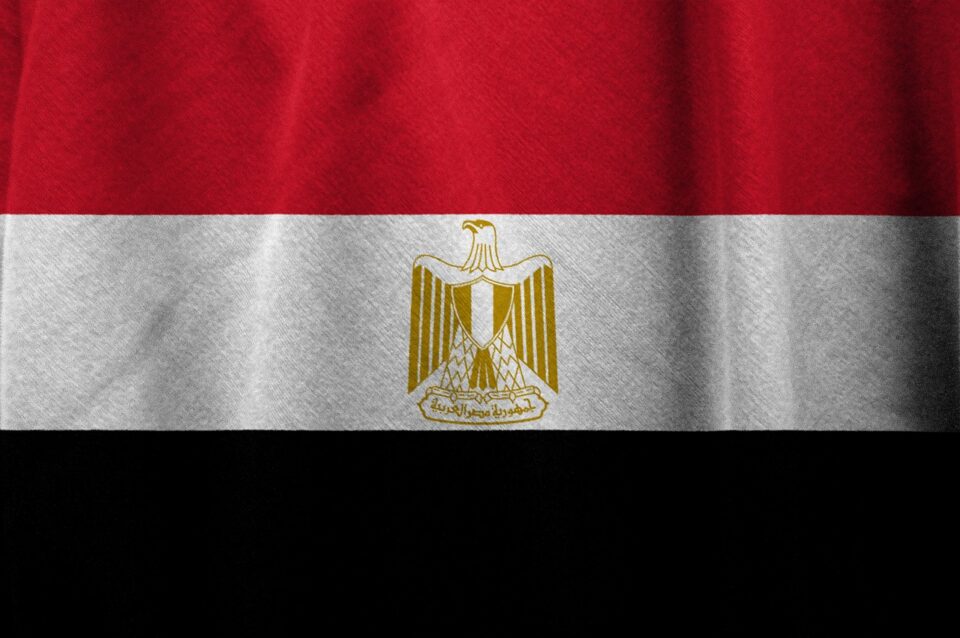
EGYPT
GEOGRAPHY
Without the Nile River, all of Egypt would be desert. Only about an inch (2.5 centimeters) of rain falls throughout Egypt each year. But each summer, the river rises because of rains at its source far to the south in Ethiopia. Floods cover the river’s valleys, leaving sediments needed for trees, plants, and crops to grow. Egypt is often divided into two sections: Upper Egypt in the south and Lower Egypt in the north. The sections are named this way because the Nile flows from south to north. The river empties into the Mediterranean Sea. Southern Egypt’s landscape contains low mountains and desert. Northern Egypt has wide valleys near the Nile and desert to the east and west. North of Cairo, the capital, is the sprawling, triangular Nile River Delta. This fertile land is completely covered with farms. Even though the total surface area is about one million square kilometers, less than 5% of the land is inhabited. Egypt is divided geographically into three regions, which are further divided into 28 administrative governorates. According to the 1996 census, nearly 43% of the total urban population lived in Cairo (the Capital) and Alexandria. Cairo, the largest city in Africa, has a population of 6.790 million. The total population in 1996 was 59,272,382 million, including an estimated 2.2 million residing abroad. The population is growing at the rate of one million every eight months, which would give Egypt a population of more than 68 million by the turn of the century.

HISTORY
For almost 30 centuries—from its unification around 3100 B.C. to its conquest by Alexander the Great in 332 B.C. ancient Egypt was the preeminent civilization in the Mediterranean world. From the great pyramids of the Old Kingdom through the military conquests of the New Kingdom, Egypt’s majesty has long entranced archaeologists and historians and created a vibrant field of study all its own: Egyptology. The main sources of information about ancient Egypt are the many monuments, objects and artifacts that have been recovered from archaeological sites, covered with hieroglyphs that have only recently been deciphered. The picture that emerges is of a culture with few equals in the beauty of its art, the accomplishment of its architecture or the richness of its religious traditions.


SOCIAL CULTURE AND RELIGION
Generally, Egypt is quite a homogeneous society, with 99.6% being ethnically Egyptian. Most of the Egyptian population identify as Muslim, with the majority belonging to the Sunni variant (see ‘Islam’ in Religion). Islamic tradition has a deep influence on the identity of many Egyptians, due to its longstanding presence and position in the culture. Perhaps the most significant unifying component of the Egyptian identity is the language as nearly all Egyptians speak in the Egyptian dialect of Arabic. However, there is significant diversity within Egyptian dialects of Arabic, so much so that some native speakers may not be able to understand each other. The Egyptian Revolution brought to the forefront questions of ethnic and cultural identity regarding Egypt’s position within the wider Arab world. The country is important to the Arab world, with the Arab League headquarters being located in Cairo. Moreover, Egypt is one of the Arab world’s literary centres, producing many of modern Arabic literature’s foremost writers. However, Egyptians continue to debate whether they feel a stronger affinity to being ‘Egyptian’ or ‘Arab’ on both an individual and national level, indicating that Egyptian and Arabic culture are not synonymous. Some cultural values are generally upheld across all geographic and class distinctions in Egypt. The notion of honour (sharaf) is a central concept that guides behaviour and significantly influences interactions in Egyptian culture. It is deeply intertwined with people’s ideas about their personal dignity (karama). Traditionally, a man’s honour was determined by his ability to protect the women in his care. While many cultural ideas of honourable behaviour may still be related to patriarchal responsibility, such traditional customs tend to be prevalent only in more rural areas. Honour in modern-day Egypt is more commonly determined by the degree to which people exhibit and respect common cultural values of modesty, loyalty, honesty and hospitality. For example, the way they dress, the way they present themselves, the hospitality they show friends and guests, and the respect they give the elderly and those in authority can be perceived to reflect their honour and dignity (sharaf and karama). Pride and status is found in being helpful, generous and charitable to others. Everyone is also expected to be loyal to his family and ‘a man of his word’. As Egypt is generally a collectivist society, the needs of one’s family or community typically take precedence over one’s personal needs or desires. Religion plays a large role in Egyptian society. Islamic principles regarding law, politics and social customs continue to influence Egypt’s laws and political interactions despite Egypt’s formal status as a secular state. The vast majority of the Egyptian population (90%) identify as Muslim, mostly of the Sunni denomination. Of the remaining population, 9% identify as Coptic Orthodox Christian and the remaining 1% identify with some other denomination of Christianity. While these statistics give an overview of the religious landscape of Egypt, there is also a small but growing number of people who identify as atheist or nonreligious, as well as some who consider themselves to be Muslim by birth but not by devotion.
POLITICS
The president is Abdel fattah El-Sisi (since June 2014 ; re-elected for a second term in March 2018). The Prime Minister is Mostafa Madbouli (since June 2018).
Egypt’s presidential elections of March 2018 posed little challenge to incumbent Abdel-Fattah el-Sissi being re-elected with 97% of votes, after all serious opposition contenders halted their campaign two months before the election. The main challenger was arrested, prompting other challengers to withdraw their campaign on possible grounds of intimidation. Official turnout was also much lower than the previous election, around 41%.
In 2019, a constitutional referendum allowed President Abdel Fattah el-Sisi to remain in power until 2030 (instead of 2022 as per the previous regulations), as well as re-introducing an upper chamber – the Senate – in the Parliament, after its abolition in the 2014 Constitution. Moreover, the amendments strengthened the powers of the president over the judiciary, giving him the power to appoint the head of the Supreme Constitutional Court and making him the head of the Higher Council for Judicial Authorities, which appoints the public prosecutor and judicial leaders. The 2020 elections strengthened parliament’s pro-presidential group and weakened opposition voices. Egypt plays a pivotal role in regional stability and the fight against terrorism, but tensions remain with Ethiopia regarding the construction of the Grand Renaissance Dam upstream of the Nile, on which about 90% of the country’s drinking water supply depends
ECONOMY
After having recovered from the internal political crisis and revolutionary uprising of 2011, the Egyptian economy recently slowed down due to the outbreak of the COVID-19. According to IMF estimates, GDP growth fell from 5.6% in 2019 to 3.5% in 2020. Despite this slowdown, Egypt was one of the few countries with positive growth rate in 2020. According to the IMF’s October 2020 forecast, GDP growth is projected to fall further to 2.8% in 2021 and recover to 5% in 2022, subject to a post-pandemic global economic recovery. In its most recent January 2021 update of the World Economic Outlook, the IMF has revised its GDP growth projections for Egypt to 2.8% in 2021 and 5.5% in 2022 (representing a difference from October 2020 WEO projections of +0.5% in 2022). In 2020, Egypt’s economy was impacted by the COVID-19 pandemic, but proactive measures taken to address health and social needs and support the most directly affected sectors helped mitigate the economic and human impact of the crisis (IMF). The Egyptian economy was supported by the allocation of EGP 100 billion, representing 2% of the GDP (Egypt Oil & Gas). In addition, before the pandemic, the country was already in a strong position as it had implemented an economic reform program comprising fiscal consolidation measures, the introduction of a floating exchange rate and large cuts in subsidies. In June 2020, Egypt adopted an economic reform program supported by a 12-month Stand-By Arrangement (SBA) with the IMF. This program was designed to support the country in the context of the COVID-19 crisis. In 2020, the budget deficit increased slightly to -7.5% of GDP (from -7.2%), and is expected to widen to -8.5% in 2021 before decreasing again in 2022 (-5.7%) thanks to economic recovery. Public debt-to-GDP ratio increased to 86.6% in 2020 (from 83.8%) and is expected to reach 90.6% in 2021 before declining again in 2022 (to 87.8%). Appropriate monetary policy allowed the inflation rate to further decrease in 2020, reaching 5.7%. It should remain under control despite an expected increase to 6.2% in 2021 and 7.9% in 2022. For 2021, the priority is to support the economic recovery as the external environment remains fragile and risks include a second wave of COVID-19, less favorable financing conditions for emerging markets, and a drop in remittances (IMF). Agriculture contributes 11% of the GDP (World Bank, 2019) and employs 23% of the active population (World Bank, 2020). The sector has historically been important for Egypt, and it accounts for about 20% of total exports and foreign exchange earnings. It appears as the most resilient sector in the context of the COVID-19 pandemic. The warm climate and the abundant Nile water allow for several annual harvests. The main crops are cereals, cotton, sugar cane and beetroots. Egypt’s non-oil industry remains rather limited. With automotive manufacturing, steel manufacturing, cotton cultivation, textile production and the construction industry, the secondary sector accounts for 35.6% of the GDP and employs 28% of the workforce. In spite of economic diversification efforts, the country continues to depend on the Suez Canal for a large part of its foreign income. In 2020, the Suez Canal Authority generated USD 5.61 billion revenues (Egypt Oil&Gas). Despite the COVID-19 pandemic, Egypt announced record oil production levels, exceeding 650,000 barrels per day. The country also became the 13th gas producer in the world (Le360Afrique), its production increasing by 12.4% during financial year 2019-2020 (Africa Oil & Power). Finally, the services sector represents 50.5% of the Egyptian GDP and employs nearly half of the population (49%). It is largely dominated by revenues from telecommunications and tourism sectors. Due to the COVID-19 pandemic, the services surplus declined by 31.2% to USD 9.0 billion (from USD 13.0 billion), mainly as a result of the decrease in tourism revenues. Travel receipts fell by 54.9% between January and June 2020.

INTERNATIONAL RELATIONS
Trade represents 43% of the country’s GDP (World Bank, 2019). The Egyptian market has been gradually opening up, with the ratification of various free trade agreements, especially the European Free Trade Association (EFTA). The African continental free trade area (AfCFTA) was ratified by Egypt in 2019. Petroleum products (oil and gas) are the most traded items, both for imports and exports. Other important exports are gold and nitrogenous fertilisers. Imports are driven by petroleum (as Egypt’s reserves are much less significant than those of other Gulf countries), cars, medicines, radio-telephony transmission tools and cereals (the country imports around 40% of its food requirements according to FAO) (World Trade Organisation and International Trade Center, 2019). Due to the COVID-19 pandemic, the volume of exports of goods and services is expected to decline by -1.6% in 2020 compared to 2019, and the volume of imports to decline by -6.2%. For 2021, the IMF forecasts an unprecedented fall in volume of -21.8% for exports and -17.7% for imports.
Egypt’s main export partners are the United States (7.2% of total exports), the United Arab Emirates (6.8%), Turkey (5.7%), Saudi Arabia (5.6%), Italy (5.5%) and the United Kingdom (5.1%). Egypt’s main suppliers are China (15.3% of total imports), the United States (6.6%), Saudi Arabia (6.6%), Germany (5.5%) and Turkey (4.7%) (International Trade Center, 2019).
Structurally, the Egyptian economy has a trade deficit. Excluding services, the deficit decreased in 2019 as imports of goods decreased by 1.5%, reaching USD 70.9 billion, while exports grew by 4.9%, reaching around USD 29 billion. As for services, Egypt exported USD 24.3 billion worth of services in 2019, while it imported USD 20.2 billion (World Trade Organisation). According to Egypt Oil & Gas, the trade deficit decreased by 17% during the first 11 months of 2020, as imports decreased faster than exports. Indeed, despite the COVID-19 pandemic, exports recorded USD 58.11 billion during the first 11 months of 2020, compared to about USD 65.83 billion in the same period in 2019.
